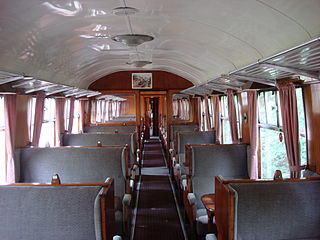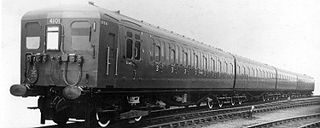
The British RailClass 411 (4CEP) electric multiple units were built at Eastleigh works from 1956–63 for the newly electrified main lines in Kent. These units, which used a British Railways Mark 1 bodyshell, were based on the earlier Southern Railway 4 COR design, built in 1937. Variants of the class 411 design included the class 410 and class 412 4 BEP units, which contained a buffet car in place of a standard trailer. They were later used on services in Sussex and Hampshire; following the privatisation of British Rail in 1995, the units were used by the Connex South Central, Connex South Eastern and South West Trains franchises. They were replaced by Juniper, Desiro, and Electrostar units. The fleet's lifespan was 49 years. These units are the longest-lived BR Mark 1 EMUs.

The British Rail Class 421 (4CIG) electric multiple units were built at BR's Holgate Road carriage works between 1964 and 1972. Units were built in two batches, and were initially introduced on services on the Brighton Main Line. Later units were introduced on services to Portsmouth. These units replaced older Southern Railway-designed units, such as the 5Bel "Brighton Belle" units, and 4Cor units. The fleet's lifespan was 46 years.

The British Rail Class 487 electric multiple units were built by English Electric in 1940, for use on the Waterloo & City line.

The PEP Stock were prototype electric multiple units used on British Rail's Southern and Scottish Regions during the 1970s and early 1980s. They were forerunners of the British Rail Second Generation electric multiple unit fleet. Three units were built, one two-car unit (2001), and two four-car units (4001/4002). Under TOPS, the driving cars were originally classified as Class 461 with the non-driving motor cars as Class 462. They were later reclassified as Class 445 (4PEP) and Class 446 (2PEP).

The British Rail TC multiple units were unpowered fixed formations of 3 or 4 carriages with a driving position at each end of the set, converted by BR's Holgate Road carriage works from locomotive-hauled Mark 1 carriages in 1966–1967 and 1974. The units built on experience gained from the prototype 6TC unit. In time the 3 car units were reformed into four car units to match the rest of the fleet and later classified as Class 442. This was later changed to Class 491, under which they spent the majority of their working lives. Shortly before withdrawal they were reclassified Class 438 and the units were renumbered to 8001-8034.

British Railways Mark 1 is the family designation for the first standardised designs of railway carriages built by British Railways (BR) from 1951 until 1974, now used only for charter services on the main lines or on preserved railways.

The Southern Railway (SR) gave the designation 5-BEL to the five-car all-Pullman electric multiple units which worked the prestigious Brighton Belle trains between London Victoria and Brighton. These units survived long enough in British Rail ownership to be allocated TOPS Class 403. Between 1933 and 1935 the units were designated 5-PUL.
The Southern Railway (SR) gave the designations 6 PUL, 6 CITY and 6 PAN to electric multiple units built to work the routes between London and Brighton, West Worthing and Eastbourne. None of these units survived long enough in British Rail ownership to be allocated a TOPS class number. The 6 PUL units were designated 6 COR until 1935.

The Southern Railway (SR) gave the designation 2-BIL to the DC third rail electric multiple units built during the 1930s to work long-distance semi-fast services on the newly electrified lines from London to Eastbourne, Portsmouth and Reading. This type of unit survived long enough in British Rail ownership to be allocated TOPS Class 401.
The Southern Railway (SR) gave the designation 2-NOL to the electric multiple units built during the 1930s from old London and South Western Railway carriage bodies on new underframes. None of these units survived long enough in British Rail ownership to be allocated a TOPS class.

The Southern Railway (SR) in the UK gave the designation SL to the fleet of AC overhead electric multiple units used on the South London Line between Victoria and London Bridge station. These had been built by the London, Brighton and South Coast Railway in 1909, but with the abandonment of the Elevated Electric service in 1928 they were converted to DC third rail units.
The Southern Railway (SR) gave the designation CW to the fleet of AC electric multiple units used on the lines to Coulsdon and Wallington. They were planned by the London, Brighton and South Coast Railway but were delayed by the World War I and the grouping and were introduced by the Southern Railway.
The Southern Railway (SR) gave the designation CP to the fleet of AC electric multiple units used on the former London, Brighton and South Coast Railway lines in the Crystal Palace area.

The British Rail Class 432 (4-REP) electric multiple unit passenger trains were built by BR at York Works from 1966 to 1967 and in 1974. The units were built to power the TC trailer units on services on the South West Main Line. Fifteen four-car units were eventually built. The motor coaches were new build, but the trailers were converted from Mk1 hauled stock. They were initially classified as Class 441 and numbered 3001–3015. This was later changed to Class 430, under which they spent the majority of their working lives. Shortly before withdrawal they were reclassified Class 432 and the units were renumbered as 2001–2015. The fleet had a lifespan of 26 years.

An electric multiple unit (EMU) is an electric train capable of operating in multiple with other EMUs that does not have a separate locomotive, typically passenger trains with accommodation in every vehicle and a driving position at each end. The term can also be used to describe a train such as the Advanced Passenger Train that was a permanent formation with a non-driving power car. As of December 2010 two-thirds of the passenger carriages in Britain are formed in EMUs.

Pullman trains in Great Britain were mainline luxury railway services that operated with first-class coaches and a steward service, provided by the British Pullman Car Company (PCC) from 1874 until 1962, and then by British Railways from 1962 until 1972. Many named mainline service trains have subsequently used the word 'Pullman' in their titles, but most of these have been normal trains with increased first-class accommodation. Since 1982 however, some railtours have been operated by companies using Pullman coaches dating from the 1920s to 1950s to recreate the ambience of the heyday of Pullman travel.

The Southern Railway (SR) and the British Railways used the designation Sub to cover a wide variety of electric multiple-unit passenger trains that were used on inner-suburban workings in the South London area. The designation 'Sub' was first officially used in 1941 to refer to newly built 4-car units. However, during the 1940s large numbers of earlier '3-Car Suburban Sets' were increased to four cars by the addition of an 'Augmentation' trailer, and became part of the 4-Sub category. The SR and BR (S) continued to build or else rebuild 4-car units to slightly different designs which became part of the 4-Sub Class. Many of these later examples survived in passenger use until late 1983, by which time British Rail had allocated to them TOPS Class 405.
Preserved EMUs of Southern Railway. This is a list of preserved Southern Railway (UK) designated electric multiple units (EMUs).

Class 201, Class 202 and Class 203 were the TOPS codes for a series of Diesel-electric multiple units built for the Southern Region of British Railways in 1957–86. They were classified by the Southern Region as 6S, 6L and 6B respectively, and known collectively as the Hastings Diesels or Hastings Units. They were built for service on the Hastings Line, which had a restricted loading gauge due to deficiencies in the construction of the tunnels when the line was built between 1845 and 1852. The Hastings Units served from 1957 to 1988, being withdrawn when the Hastings Line was electrified with single-track sections through some of the tunnels.

The Electrification of the LSWR refers to the installation of electric traction on the London and South Western Railway surface network, and its successor the Western Section of the Southern Railway, in England. The LSWR started a programme of electrification in response to rising costs and loss of traffic to street tramways; the first installation was to Kingston, Richmond, Hounslow, Hampton Court and Shepperton, starting in 1917. The third rail DC system was used, as it was assessed to be considerably cheaper to install and maintain than the overhead systems then in use. The rolling stock was constructed by the conversion of relatively new coaches built for suburban steam-hauled operation. The LSWR generated its own electric power at a new power station near Wimbledon. A frequent regular-interval timetable was implemented and the system was a considerable success.

















